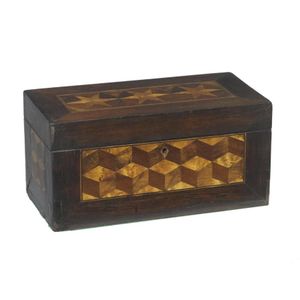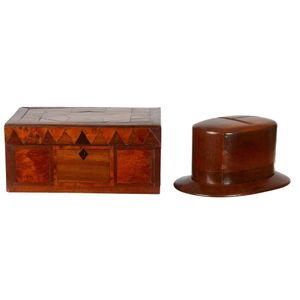Australian Wood Box and Top Hat Money Box
You must be a subscriber, and be logged in to view price and dealer details.
Subscribe Now to view actual auction price for this item
When you subscribe, you have the option of setting the currency in which to display prices to $Au, $US, $NZ or Stg.
- Huon Pine - Named after the Frenchman who discovered the Huon River in Tasmania, it is an extremely slow growing and long living tree. Huon pine is native to Tasmania, and it can grow to an age of 3,000 years or more. The wood contains oil that retards the growth of fungi, hence its early popularity in ship-building in convict-era Tasmania. The timber is a warm yellow colour, finely grained, and was popular for household furniture in the Victorian era. Interestingly, much Huon pine furniture was made in South Australia. Huon pine is a protected species and only limited quantities are available nowadays, for craftsmen to manufacture small items such as platters, sculptures and other decorative objects.
- Blackwood - One of the best known and most widely used Australian timbers, blackwood (acacia melanoxylon), is a member of the Acacia (wattle) family and grows in eastern Australia from about Adelaide in South Australia, as far north as Cairns in Queensland.
The largest, straightest and tallest trees come from the wet forest and swamps of north-west Tasmania where it is grown commercially.
Blackwood timber colours range across a wide spectrum, from a very pale honey colour through to a dark chocolate with streaks of red tinge.
The hardwood timber has been commonly used in the production of furniture, flooring, and musical instruments in Australia from the late 19th century. However, the straight grain timber is not the most prized or valuable, that honour falls to blackwood with a wavy, fiddleback pattern, which is used both in the solid and as a veneer. Fiddleback was only used on the finest examples of furniture. - Oak - Native to Europe and England, oak has been used for joinery, furniture and building since the beginning of the medieval civilisation. It is a pale yellow in colour when freshly cut and darkens with age to a mid brown colour.
Oak as a furniture timber was superceded by walnut in the 17th century, and in the 18th century by mahogany,
Semi-fossilised bog oak is black in colour, and is found in peat bogs where the trees have fallen and been preserved from decay by the bog. It is used for jewellery and small carved trinkets.
Pollard oak is taken from an oak that has been regularly pollarded, that is the upper branches have been removed at the top of the trunk, result that new branches would appear, and over time the top would become ball-like. . When harvested and sawn, the timber displays a continuous surface of knotty circles. The timber was scarce and expensive and was used in more expensive pieces of furniture in the Regency and Victorian periods. - Casuarina - Casuarina, is also known as beefwood (because of its appearance) she-oak, swamp oak, river oak, forest oak and Botany Bay wood. It is a native Australian hardwood, red brown in colour with dark flecks.
This item has been included into following indexes:
- boxes, material or decoration
Visually similar items

A Victorian burr walnut writing box, 19th century, with modern lining, the well figured dome top box, finely refurbished with a contemporary cartouche and pale blue lining and key, height 15.5 cm, length 30 cm, width 23 cm

An Australian specimen wood inlaid huon pine and rosewood parquetry tea caddy, 19th century, the rectangular top onlaid with a pattern of three stars, the font panel parquetry work, 25 cm wide, 13 cm deep, 12 cm high

A Victorian rosewood ladies dressing box, mid to late 19th century, decorated with brass and mother of pearl inlay the box interior fitted with compartments for perfume bottles, jewellery and personal items with secretive lower side-spring action drawer to

A Victorian brass bound walnut writing box, 40 cm wide, 25 cm deep, 18 cm high
